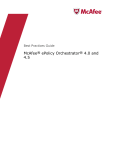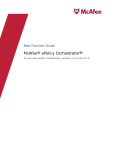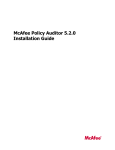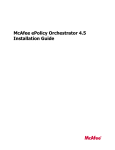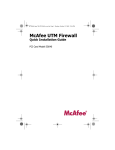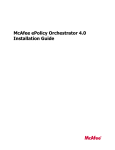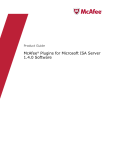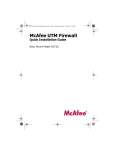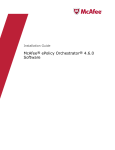Download Red Hat NETSCAPE MANAGEMENT SYSTEM 6.0 - AGENT GUIDE Installation guide
Transcript
McAfee Policy Auditor 6.0.0 software Installation Guide COPYRIGHT Copyright © 2011 McAfee, Inc. All Rights Reserved. No part of this publication may be reproduced, transmitted, transcribed, stored in a retrieval system, or translated into any language in any form or by any means without the written permission of McAfee, Inc., or its suppliers or affiliate companies. TRADEMARK ATTRIBUTIONS AVERT, EPO, EPOLICY ORCHESTRATOR, FOUNDSTONE, GROUPSHIELD, INTRUSHIELD, LINUXSHIELD, MAX (MCAFEE SECURITYALLIANCE EXCHANGE), MCAFEE, NETSHIELD, PORTALSHIELD, PREVENTSYS, SECURITYALLIANCE, SITEADVISOR, TOTAL PROTECTION, VIRUSSCAN, WEBSHIELD are registered trademarks or trademarks of McAfee, Inc. and/or its affiliates in the US and/or other countries. McAfee Red in connection with security is distinctive of McAfee brand products. All other registered and unregistered trademarks herein are the sole property of their respective owners. LICENSE INFORMATION License Agreement NOTICE TO ALL USERS: CAREFULLY READ THE APPROPRIATE LEGAL AGREEMENT CORRESPONDING TO THE LICENSE YOU PURCHASED, WHICH SETS FORTH THE GENERAL TERMS AND CONDITIONS FOR THE USE OF THE LICENSED SOFTWARE. IF YOU DO NOT KNOW WHICH TYPE OF LICENSE YOU HAVE ACQUIRED, PLEASE CONSULT THE SALES AND OTHER RELATED LICENSE GRANT OR PURCHASE ORDER DOCUMENTS THAT ACCOMPANY YOUR SOFTWARE PACKAGING OR THAT YOU HAVE RECEIVED SEPARATELY AS PART OF THE PURCHASE (AS A BOOKLET, A FILE ON THE PRODUCT CD, OR A FILE AVAILABLE ON THE WEBSITE FROM WHICH YOU DOWNLOADED THE SOFTWARE PACKAGE). IF YOU DO NOT AGREE TO ALL OF THE TERMS SET FORTH IN THE AGREEMENT, DO NOT INSTALL THE SOFTWARE. IF APPLICABLE, YOU MAY RETURN THE PRODUCT TO MCAFEE OR THE PLACE OF PURCHASE FOR A FULL REFUND. 2 McAfee Policy Auditor 6.0.0 Installation Guide Contents Introducing McAfee Policy Auditor. . . . . . . . . . . . . . . . . . . . . . . . . . . . . . . . . . . . . . . . . . . . . . . . . . . . . . . . . 4 Product components. . . . . . . . . . . . . . . . . . . . . . . . . . . . . . . . . . . . . . . . . . . . . . . . . . . . . . . . . . . . . . . . . . . . . . . . 4 Audience. . . . . . . . . . . . . . . . . . . . . . . . . . . . . . . . . . . . . . . . . . . . . . . . . . . . . . . . . . . . . . . . . . . . . . . . . . . . . . . . . 4 Conventions. . . . . . . . . . . . . . . . . . . . . . . . . . . . . . . . . . . . . . . . . . . . . . . . . . . . . . . . . . . . . . . . . . . . . . . . . . . . . . 5 Finding product documentation. . . . . . . . . . . . . . . . . . . . . . . . . . . . . . . . . . . . . . . . . . . . . . . . . . . . . . . . . . . . . . . 5 Pre-Installation Tasks. . . . . . . . . . . . . . . . . . . . . . . . . . . . . . . . . . . . . . . . . . . . . . . . . . . . . . . . . . . . . . . . . . . . . . . . 6 Preparation for installing the software. . . . . . . . . . . . . . . . . . . . . . . . . . . . . . . . . . . . . . . . . . . . . . . . . . . . . . . . . . 6 System requirements. . . . . . . . . . . . . . . . . . . . . . . . . . . . . . . . . . . . . . . . . . . . . . . . . . . . . . . . . . . . . . . . . . . . . . . 6 Server requirements. . . . . . . . . . . . . . . . . . . . . . . . . . . . . . . . . . . . . . . . . . . . . . . . . . . . . . . . . . . . . . . . . 6 Distributed repository requirements. . . . . . . . . . . . . . . . . . . . . . . . . . . . . . . . . . . . . . . . . . . . . . . . . . . 10 McAfee Agent and ePolicy Orchestrator support. . . . . . . . . . . . . . . . . . . . . . . . . . . . . . . . . . . . . . . . . 10 McAfee Policy Auditor agent plug-in platforms and support. . . . . . . . . . . . . . . . . . . . . . . . . . . . . . . . 10 Agentless audit support. . . . . . . . . . . . . . . . . . . . . . . . . . . . . . . . . . . . . . . . . . . . . . . . . . . . . . . . . . . . . 12 Database considerations and support. . . . . . . . . . . . . . . . . . . . . . . . . . . . . . . . . . . . . . . . . . . . . . . . . . . . . . . . 12 Database storage requirements. . . . . . . . . . . . . . . . . . . . . . . . . . . . . . . . . . . . . . . . . . . . . . . . . . . . . . 14 Estimating database storage requirements. . . . . . . . . . . . . . . . . . . . . . . . . . . . . . . . . . . . . . . . . . . . . 15 Database storage example and requirements table. . . . . . . . . . . . . . . . . . . . . . . . . . . . . . . . . . . . . . . 15 Database storage requirements for File Integrity Monitoring. . . . . . . . . . . . . . . . . . . . . . . . . . . . . . . . 16 Database storage requirements for file versioning. . . . . . . . . . . . . . . . . . . . . . . . . . . . . . . . . . . . . . . . 17 Server requirements. . . . . . . . . . . . . . . . . . . . . . . . . . . . . . . . . . . . . . . . . . . . . . . . . . . . . . . . . . . . . . . . 18 Estimating database storage requirements. . . . . . . . . . . . . . . . . . . . . . . . . . . . . . . . . . . . . . . . . . . . . 18 Installing McAfee Policy Auditor. . . . . . . . . . . . . . . . . . . . . . . . . . . . . . . . . . . . . . . . . . . . . . . . . . . . . . . . . . . 19 Install McAfee Policy Auditor on an MSCS cluster. . . . . . . . . . . . . . . . . . . . . . . . . . . . . . . . . . . . . . . . . . . . . . . 19 Install McAfee Policy Auditor as an extension on ePolicy Orchestrator software. . . . . . . . . . . . . . . . . . . . . . . 20 Update McAfee Policy Auditor content. . . . . . . . . . . . . . . . . . . . . . . . . . . . . . . . . . . . . . . . . . . . . . . . . . . . . . . . 20 Check in additional agent plug-in packages. . . . . . . . . . . . . . . . . . . . . . . . . . . . . . . . . . . . . . . . . . . . . . . . . . . . 21 Install the McAfee Vulnerability Manager extension. . . . . . . . . . . . . . . . . . . . . . . . . . . . . . . . . . . . . . . . . . . . . . 21 Uninstall McAfee Policy Auditor. . . . . . . . . . . . . . . . . . . . . . . . . . . . . . . . . . . . . . . . . . . . . . . . . . . . . . . . . . . . . . 22 McAfee Policy Auditor 6.0.0 Installation Guide 3 Introducing McAfee Policy Auditor ® McAfee Policy Auditor automates the process required to conduct system compliance audits. It measures compliance by comparing the actual configuration of a system to the desired state of a system. This guide provides system requirements for McAfee Policy Auditor software, and information about installing it as a managed product, as well as modifying, repairing, removing, and reinstalling the software. Contents Product components Audience Conventions Finding product documentation Product components McAfee Policy Auditor software consists of several components that are used to create benchmarks, audit systems, and display results. The McAfee Agent and the McAfee Policy Auditor agent plug-in do not need to be installed on ® systems that are audited by McAfee Vulnerability Manager. These are the McAfee Policy Auditor components as they appear in the user interface: • Benchmark Editor — A utility used to enable, disable, create, and edit benchmarks. Each audit must contain at least one benchmark. Ideally, audits should contain only one benchmark. • Benchmark Editor Content Distributor — Distributes content downloaded from McAfee TM Labs to systems. • Findings — Manages findings, which help you understand why an audit check failed and information about how to fix the problem. • PACore — The primary portion of the software that controls all other features. • PARollup — Uses the rollup capabilities of ePolicy Orchestrator to collect summary information from registered ePolicy Orchestrator servers and show aggregated data. • Policy Auditor — Handles policy and task management, audit schedules, and system management. Audience McAfee documentation is carefully researched and written for the target audience. The information in this guide is intended primarily for: 4 McAfee Policy Auditor 6.0.0 Installation Guide Introducing McAfee Policy Auditor Conventions • Administrators — People who implement and enforce the company's security program. • Users — People who are responsible for configuring the product options on their system, or for updating the product on their systems. Conventions This guide uses the following typographical conventions. Book title or Emphasis Title of a book, chapter, or topic; introduction of a new term; emphasis. Bold Text that is strongly emphasized. User input or Path Commands and other text that the user types; the path of a folder or program. Code A code sample. User interface Words in the user interface including options, menus, buttons, and dialog boxes. Hypertext blue A live link to a topic or to a website. Note Additional information, like an alternate method of accessing an option. Tip Suggestions and recommendations. Important/Caution Valuable advice to protect your computer system, software installation, network, business, or data. Warning Critical advice to prevent bodily harm when using a hardware product. Finding product documentation McAfee provides the information you need during each phase of product implementation, from installing to using and troubleshooting. After a product is released, information about the product is entered into the McAfee online KnowledgeBase. 1 Go to the McAfee Technical Support ServicePortal at http://mysupport.mcafee.com. 2 Under Self Service, access the type of information you need: To access... Do this... User Documentation 1 Click Product Documentation. 2 Select a Product, then select a Version. 3 Select a product document. KnowledgeBase • Click Search the KnowledgeBase for answers to your product questions. • Click Browse the KnowledgeBase for articles listed by product and version. McAfee Policy Auditor 6.0.0 Installation Guide 5 Pre-Installation Tasks Before installing McAfee Policy Auditor, you need to make sure your system is ready and meets the minimum software and hardware requirements. This section presents information to help plan and prepare your system before installing the software. Contents Preparation for installing the software System requirements Database considerations and support Preparation for installing the software Complete these tasks before installing the McAfee Policy Auditor software. 1 Get the McAfee Policy Auditor software and documentation from the McAfee download site: https://secure.nai.com/us/forms/downloads/upgrades/login.asp 2 Review the release notes to identify last minute changes or known issues. 3 Verify that you have local administrator rights for the computer where you plan to install McAfee Policy Auditor. 4 Verify that your server or workstation meets the system requirements before you start the installation process. Refer to System requirements for details. 5 If you are installing a licensed version over an evaluation version of McAfee Policy Auditor, you must upgrade the license. The license is not automatically upgraded from an evaluation version. System requirements Verify that your server and systems to be audited meet these system requirements before you start the installation process. NOTE: Unless otherwise specified, these are minimum requirements and are not optimal for performance. They apply only to McAfee Policy Auditor. You must also consider system requirements for any other products you are installing, such as McAfee Vulnerability Manager. Server requirements This section contains information you need to know before installing the McAfee Policy Auditor software, including hardware and software requirements. 6 McAfee Policy Auditor 6.0.0 Installation Guide Pre-Installation Tasks System requirements Supported ePolicy Orchestrator software versions One of these versions of ePolicy Orchestrator software must be installed and working before you install the software: • ePolicy Orchestrator software version 4.5 Patch 5 or greater • ePolicy Orchestrator software version 4.6 Domain controller requirements The server must have a trust relationship with the Primary Domain Controller (PDC) on the network. For instructions, see the Microsoft product documentation. Supported operating systems McAfee Policy Auditor is installed as an extension of ePolicy Orchestrator software and runs on operating systems supported by that product. For the most current information about supported operating systems, see this article in the McAfee KnowledgeBase: https://kc.mcafee.com/corporate/index?page=content&id=KB51569. Microsoft operating system Latest supported SP ePO 4.5 ePO 4.6 Microsoft Windows 2008 Server Release 2, (64-bit) (Standard, Enterprise, and Datacenter) — Yes* Yes Microsoft Windows 2008 Server (64-bit) (Standard, Enterprise, and Datacenter) 2 Yes Yes Microsoft Windows 2008 Server (32-bit) (Standard, Enterprise, and Datacenter) 2 Yes Yes Microsoft Windows 2003 Storage Server 2 Yes No Microsoft Windows 2003 Server Release 2 2 Yes Yes Microsoft Windows 2003 Server Release 2 (64-bit) 2 Yes Yes Microsoft Windows 2003 Server 2 Yes Yes Microsoft Windows 2003 Server (64-bit) 2 Yes Yes Microsoft Windows 2003 Web 1 Yes No Microsoft Windows 2008 Small Business Server Premium — No Yes * ePolicy Orchestrator software supports Microsoft Windows 2008 Server Release 2 Patch 1 and greater. Browsers supported ePolicy Orchestrator software runs on the most commonly-used browsers and can be accessed from anywhere on the network. For the most current information about ePolicy Orchestrator software virtual infrastructure support, see this article on the McAfee KnowledgeBase: https://kc.mcafee.com/corporate/index?page=content&id=KB51569. Browser ePO 4.5 ePO 4.6 Microsoft Internet Explorer 9.0 No* No* Microsoft Internet Explorer 8.0 Yes Yes Microsoft Internet Explorer 7.0 Yes Yes Microsoft Internet Explorer 6.0 No No McAfee Policy Auditor 6.0.0 Installation Guide 7 Pre-Installation Tasks System requirements Browser ePO 4.5 ePO 4.6 Microsoft Internet Explorer 5.5 No No Mozilla Firefox 4.0 No* No* Mozilla Firefox 3.6 Yes (with ePO 4.5 Patch 4 and greater) Yes Mozilla Firefox 3.5 No Yes Mozilla Firefox 3.0 Yes No * McAfee plans to test and provide support for Internet Explorer 9 and Firefox 4 in upcoming patch releases Proxy servers If you are using a proxy, bypass the proxy server: 1 From the Internet Explorer Tools menu, select Internet Options. 2 Select the Connections tab and click LAN Settings. 3 Select Use a proxy server for your LAN, then select Bypass proxy server for local addresses. 4 Click OK, then click OK again. Ports needed by ePolicy Orchestrator software for communication through a firewall ePolicy Orchestrator software uses ports to communicate with web browsers, SQL Server, managed systems, the network, and other portions of the software. For the most current information about ports use by ePolicy Orchestrator software, see this article in the McAfee KnowledgeBase: https://kc.mcafee.com/corporate/index?page=content&id=KB66797. This table shows the ports needed by ePolicy Orchestrator software versions 4.5 and 4.6 for communication through a firewall. 8 Port Default Description Traffic direction Agent to server communication port 80 TCP port opened by the ePolicy Orchestrator software server service to receive requests from agents. Inbound/Outbound connection to/from the ePolicy Orchestrator software server/Agent Handler. Agent communicating over SSL (4.5 and later agents only) 443 By default, agents should communicate over SSL (443 by default). Inbound/Outbound connection to/from the ePO server/Agent Handler. Agent wake-up 8081 communication port SuperAgent repository port TCP port opened by agents to receive agent wakeup requests from the ePolicy Orchestrator software server. TCP port opened to replicate repository content to a SuperAgent repository. Outbound connection from the ePolicy Orchestrator software server/Agent Handler. Agent broadcast communication port UDP port opened by SuperAgents to forward messages from the ePolicy Orchestrator software server/Agent Handler. Outbound connection from the SuperAgents. 8082 McAfee Policy Auditor 6.0.0 Installation Guide Pre-Installation Tasks System requirements Port Default Description Traffic direction Console-to-application server communication port 8443 HTTPS port opened by the ePolicy Orchestrator software Application Server service to allow web browser UI access. Inbound connection to the ePolicy Orchestrator software server. Sensor-to-server communication port 8444 HTTPS port opened by the ePolicy Orchestrator software Application Server service to receive RSD connections. Also, used by the Agent Handler to talk to the ePolicy Orchestrator software server to get required information (like LDAP servers). Inbound connection to the ePolicy Orchestrator software server. Outbound connection from remote Agent Handlers. Security threats communication port 881 HTTP port hosted by McAfee Labs for Outbound connection from retrieving security threat feed. Note that this the ePolicy Orchestrator port cannot be changed. software server. SQL server TCP port 1433 TCP port used to communicate with the SQL server. This port is specified or determined automatically during the setup process. SQL server UDP port 1434 UDP port used to request the TCP port that Outbound connection from the SQL instance hosting the ePolicy the ePolicy Orchestrator Orchestrator software database is using. software server/Agent Handler. Default LDAP server port 389 LDAP connection to look up computers, Outbound connection from users, groups, and Organizational Units for the ePolicy Orchestrator User Based Policies. software server/Agent Handler. Default SSL LDAP server port 646 User Based Policies use the LDAP connection to look up users, groups, and Organizational Units. Outbound connection from the ePolicy Orchestrator software server/Agent Handler. Outbound connection from the ePolicy Orchestrator software server/Agent Handler. Supported virtual infrastructure software ePolicy Orchestrator software runs on the most commonly-used virtual infrastructure software. For the most current information about ePolicy Orchestrator software virtual infrastructure support, see this article on the McAfee KnowledgeBase: https://kc.mcafee.com/corporate/index?page=content&id=KB51569. Virtual software ePO 4.5 ePO 4.6 VMware ESXi 4.1 Yes Yes VMware ESX Server 4 Yes* Yes VMware ESX Server 3.5 Yes Yes VMware ESX Server 3.0.x No No VMware Workstation 5.0 Yes Yes Microsoft Virtual Server 2005 R2 with SP1 Yes Yes Windows Server 2008 R2 Hyper-V TBD Yes Windows Server 2008 Hyper-V Yes Yes Citrix XenServer 5.5 No Yes * ESX 4.0 is supported with ePolicy Orchestrator software 4.5 Patch 1 and higher McAfee Policy Auditor 6.0.0 Installation Guide 9 Pre-Installation Tasks System requirements Distributed repository requirements Distributed repositories host copies of your master repository’s contents. Consider using distributed repositories and strategically placing them throughout your network to ensure that managed systems are updated and to minimize network traffic. As you update your master repository, the ePolicy Orchestrator software software replicates the contents to the distributed repositories. For more information on distributed repositories, see your appropriate ePolicy Orchestrator software product guides. Replication can occur: • Automatically when specified package types are checked in to the master repository, as long as global updating is enabled. • On a recurring schedule with replication tasks. • Manually, by running a Replicate Now task. Component Requirement Free disk space 100 MB on the drive where the repository is stored. Memory 256 MB minimum. McAfee Agent and ePolicy Orchestrator support McAfee Policy Auditor software supports McAfee Agent versions 4.5 and 4.6. The available features depend upon the agent version and the ePolicy Orchestrator software version. ePO server version McAfee Agent version Notes 4.6 4.6 Work together to support all legacy and new features. 4.6 4.5 Supports all legacy features. Some of the new features of ePolicy Orchestrator software version 4.6 and McAfee Agent4.6 are not available. 4.5 4.6 Supports all legacy features. Some of the new features of McAfee Agent4.6 are not available. 4.5 4.5 Work together to support all legacy features. McAfee Policy Auditor agent plug-in platforms and support The McAfee Policy Auditor agent plug-in supports a number of common enterprise platforms. Operating system X86 support X64 support Other processors AIX 5.3 TL8 SP5 Power5, Power6 AIX 6.1 TL2 SP0 Power5, Power6 Apple Mac OS X 10.4 X X PowerPC Universal binary Apple Mac OS X 10.5 X X PowerPC Universal binary Apple Mac OS X 10.6 X X PowerPC Universal binary Windows 2000 Server X HP-UX 11i v1 10 Notes McAfee Policy Auditor 6.0.0 Installation Guide RISC Pre-Installation Tasks System requirements Operating system X86 support X64 support Other processors HP-UX 11i v2 RISC HP-UX 11i v2 Itanium RISC HP-UX 11i v3 RISC HP-UX 11i v3 Itanium RISC Notes Red Hat Linux AS, ES, WS 4.0 X X 32-bit agent on 64-bit hardware Red Hat Enterprise Linux 5.0, 5.1 X X 32-bit agent on 64-bit hardware Red Hat Enterprise Linux 6.0 X X 32-bit agent on 64-bit hardware Solaris 8 SPARC Solaris 9 SPARC Solaris 10 SPARC SuSE Linux 9 X X 32-bit agent on 64-bit hardware SuSE Linux Enterprise Server 10 X X 32-bit agent on 64-bit hardware SuSE Linux Enterprise Server 11 X X 32-bit agent on 64-bit hardware Windows 2000 Advanced Server X Windows 2000 Professional X Windows XP Professional X X Native 32- and 64-bit agent Windows Server 2003 Standard Edition X X Native 32- and 64-bit agent Windows Server 2003 Enterprise Edition X X Native 32- and 64-bit agent Windows Vista X X Native 32- and 64-bit agent Windows 2008 Server X X Native 32- and 64-bit agent Windows 7 X X Native 32- and 64-bit agent Hardware and network requirements for Windows systems These are the minimum requirements for McAfee Policy Auditor agent plug-in support on Windows systems: Component Requirements Processor Intel Pentium-class, Celeron, or compatible processor; 166 MHz processor or higher. Free disk space for agent plug-in 300 MB. Free disk space for other McAfee components Sufficient disk space on client computers for each McAfee product that you plan to deploy. For more information, see the corresponding product documentation. Free Memory 20 MB RAM. McAfee Policy Auditor 6.0.0 Installation Guide 11 Pre-Installation Tasks Database considerations and support Component Requirements Network environment Microsoft or Novell NetWare networks. NetWare networks require TCP\IP. Network interface card (NIC) 10 Mbps or higher. Agentless audit support Agentless audits allow you to audit systems that do not have the McAfee Policy Auditor agent plug-in installed. You can audit systems that do not have the agent plug-in by integrating McAfee Policy Auditor with McAfee Foundstone version 6.8 or McAfee Vulnerability Manager version 7.0. To perform agentless audits, you must have a McAfee Foundstone or McAfee Vulnerability Manager server that is accessible over your network. When determining how to implement agentless auditing, you need to consider your current ePolicy Orchestrator software installation, what version of McAfee Foundstone or McAfee Vulnerability Manager software you have installed, and your plans for upgrading your ePolicy Orchestrator software server. Database considerations and support McAfee Policy Auditor software, which requires a database, uses the ePolicy Orchestrator software server database by default. If no database is present, the installer offers to place SQL Server 2005 Express on your system. Using McAfee Policy Auditor software with a database Any of the following databases, if previously installed, meet the requirements for the software. • SQL 2008 R2 Express • SQL Server 2008 • SQL Server 2005 Express with Patch 2 or greater • SQL Server 2005 CAUTION: If the minimum number of SQL Server licenses is not available after you install the SQL Server software, you might have a problem installing or starting the ePolicy Orchestrator software. These tables provide additional information about your database choices and other software requirements. Table 1: SQL server requirements Database 12 ePO 4.5 ePO 4.6 SQL 2008 R2 Express No Yes Provides an option for automatically installing .NET Framework 2.0 SP2 or 3.5 SP1. Available in 32-bit and 64-bit versions. SQL 2008 No Yes Dedicated server and network connection Needed if managing more than 5,000 systems. McAfee Policy Auditor 6.0.0 Installation Guide Requirements Notes Pre-Installation Tasks Database considerations and support Database SQL Server 2005 ePO 4.5 Yes ePO 4.6 Requirements Yes Notes Local database server If the database and McAfee Policy Auditor server are on the same system, McAfee recommends configuring your server to use a using a fixed virtual memory size that is approximately two-thirds of the total memory allotted for SQL Server. For example, if the system has 1 GB of RAM, set 660 MB as the fixed memory size for SQL Server. Licenses A license is required for each processor on the system where SQL Server is installed. If the minimum number of SQL Server licenses is not available, you might have difficulty installing or starting the ePolicy Orchestrator software server. Dedicated server and network connection Needed if managing more than 5,000 systems. Local database server If the database and McAfee Policy Auditor server are on the same system, McAfee recommends configuring your server to use a using a fixed virtual memory size that is approximately two-thirds of the total memory allotted for SQL Server. For example, if the system has 1 GB of RAM, set 660 MB as the fixed memory size for SQL Server. SQL Server 2005 64-bit is supported only if it is installed on a separate system from the ePolicy Orchestrator software server. Licenses SQL Server 2005 Express Patch 2 Yes McAfee Policy Auditor 6.0.0 Installation Guide Yes A license is required for each processor on the system where SQL Server is installed. If the minimum number of SQL Server licenses is not available, you might have difficulty installing or starting the ePolicy Orchestrator software server. • .NET Framework 2.0 You must acquire and install .NET Framework 2.0 SP2. • .NET Framework 2.0 Service Pack 2 The Installer prompts you to install SQL Server 2005 13 Pre-Installation Tasks Database considerations and support Database ePO 4.5 ePO 4.6 Requirements Notes Backward Compatibility if it is not present. Table 2: Additional software considerations Software Notes Internet browser See Browsers supported. MDAC 2.8 If not previously installed, the installation wizard installs automatically. SQL Server 2005 Backward Compatibility If required, the installer prompts you to install it. SQL Server 2005 Express If no other database has been previously installed, this database can be installed automatically at user’s selection. Microsoft updates Update the ePolicy Orchestrator software server and the database server with the most current updates and patches. MSI 3.1 The installation fails if your server is using a version of MSI earlier than MSI 3.1. Database storage requirements When determining hardware needs for your organization, it is important to estimate the amount of database storage required to use McAfee Policy Auditor software. McAfee has designed the software so that audit results consume the minimum amount of disk space. The amount of database storage you require depends on these factors: • How frequently benchmark audits are performed. • The number of systems audited. • How long you want to retain audit results. The tables used to calculate server and database requirements are based on tests of the software in the following distributed environment: • • McAfee Policy Auditor server • Four-processor, Intel Xenon 2.0GHz Core server • 4 GB of RAM • Windows 2003 Server 32-bit R2, Service Pack 2 • RAID array 5 hard drive for local storage Database server • Four-processor, Intel Xenon 2.7GHz server with hyper threading • 4 GB of RAM • Windows 2003 Server 32-bit R2, Service Pack 2 • SQL Server 2005, Service Pack 2 • RAID array 5 hard drive for local storage Effect of differential auditing results on database size McAfee Policy Auditor increases database size an average of 760 KB of space per new system audited. The differential audits feature causes the increase in database size to decrease significantly after the first audit. 14 McAfee Policy Auditor 6.0.0 Installation Guide Pre-Installation Tasks Database considerations and support The Index Configuration server setting also affects the size of the database. If you use the Minimal Indexing option, the database will be smaller than if you use one of the other options. The ultimate database size cannot be calculated accurately prior to deploying McAfee Policy Auditor, but can be estimated approximately 3 months after beginning a phased rollout. Use the database storage sizing estimates to determine the initial database size for new systems and new audits. Estimating database storage requirements You can estimate the average amount of hard disk space needed to store new McAfee audit results. 1 Determine the auditing requirements for your organization, including: • The number of audits you will be performing. • The frequency of each audit. For example, 20 audits once per quarter, 5 audits once per month, or one audit once per week. • The number of systems covered by each audit. 2 Use the example and the table in Database sizing example and requirements table to estimate the database space required for each audit. 3 Add the values for each audit. The sum is equal to the size of the database required to store the audit results for one year. 4 Determine the length of time you want to store the audits and adjust the database accordingly. For example, if you intend to store the audit results for two years, double the database size obtained in step 3. If you intend to store the audit results for six months, divide the database size by two. Database storage example and requirements table The requirements table for database sizing can help you calculate the the approximate disk space needed for your McAfee Policy Auditor database. Requirements table for database sizing Use this table to estimate the required size of your database. These estimates are based upon the average size of benchmark audit results. Your needs may vary. 1,000 systems Per system per year Frequency 2,000 systems 5,000 systems Total audits 10,000 systems 20,000 systems 50,000 systems Database size (GB) 1 yearly 1 1 3 7 14 27 68 2 yearly 2 3 5 14 27 55 127 5 yearly 5 7 14 34 68 137 342 10 yearly 10 14 27 68 137 237 684 20 yearly 20 27 55 137 273 547 1,367 4 5 11 27 55 109 273 2 quarterly 8 11 22 55 109 219 547 5 quarterly 20 27 55 137 273 547 1,367 10 quarterly 40 55 109 273 547 1,094 2,188 1 quarterly McAfee Policy Auditor 6.0.0 Installation Guide 15 Pre-Installation Tasks Database considerations and support 1,000 systems Per system per year Frequency 2,000 systems Total audits 5,000 systems 10,000 systems 20,000 systems 50,000 systems Database size (GB) 20 quarterly 80 109 219 547 1,094 2,188 1 monthly 12 16 2 monthly 24 33 5,469 33 82 164 328 820 66 164 328 656 1,641 5 monthly 60 82 164 410 820 1,641 4,102 10 monthly 120 164 328 820 1,641 3,281 8,203 20 monthly 240 328 656 1,641 3,281 6,563 16,046 1 weekly 52 71 142 355 711 1,422 3,555 2 weekly 104 142 284 711 1,422 2,844 7,109 5 weekly 260 355 711 1,777 3,555 7,109 17,773 10 weekly 520 711 1,422 3,555 7,109 14,219 35,547 20 weekly 1040 1,422 2,844 7,109 14,219 28,438 71,094 1 daily 365 499 998 2,495 4,990 9,980 24,951 2 daily 730 998 1,996 4,990 9,980 19,961 49,902 Calculating database storage requirements A corporation follows this policy for running audits: • The company retains audit results for one year. • One audit runs every three days on 2,000 systems. The table does not include this value, so we approximate this to two audits per week running on 2,000 systems. • Five monthly audits run on 5,000 systems. • One yearly audit runs on 150,000 systems. The table does not include this value, but it is equivalent to three yearly audits on 50,000 systems. • Two quarterly audits run on 10,000 systems. Calculate the approximate database size: 1 2 Look up the corresponding values in the table under Requirements table for database sizing, and note these results: Audit frequency... ...running on number of systems = Database size (GB) 2 weekly audits 2,000 systems 284 5 monthly audits 5,000 systems 410 3 yearly audits 50,000 systems (3 × 68 = 204) 204 2 quarterly audits 10,000 systems 109 Calculate the total amount of space needed: 284 + 410 + 204 + 109 = 1,007 GB Database storage requirements for File Integrity Monitoring File Integrity Monitoring (FIM) allows you to designate a set of files to monitor for changes. McAfee Policy Auditor software monitors the MD5 and SHA-1 hashes of a file as well as the file attributes and permissions information. When a file changes, the McAfee Policy Auditor agent plug-in notes the change and sends an event back to the server. 16 McAfee Policy Auditor 6.0.0 Installation Guide Pre-Installation Tasks Database considerations and support The number of FIM events depends upon the number of files monitored and the frequency of changes to monitored files. The number of events is difficult to predict, but the impact to database storage is minimal. Each FIM event adds approximately 3 kB to the database. If your organization generates one million events per month, the annual database growth is: 3 kB/event × 1,000,000 events/month × 12 months/year × 0.000001 GB/kB = 36 GB/year Database storage requirements for file versioning The File Integrity Monitoring feature of McAfee Policy Auditor software allows you to store up to six versions, including the file baseline, of text files from managed systems. The software does not support versioning for non-text files. Version database sizing chart This chart helps you calculate the database storage requirements for versioned files. The Monitored File Size column is the size of the file in megabytes for which you are storing version text. The Versions row is the number of file versions that you are storing. Versions 2 3 4 5 6 Database requirement per 1,000 systems (GB) Monitored File Size (MB) 1 0.0573 0.115 0.172 0.229 0.287 2 0.0747 0.149 0/224 0.299 0.374 3 0.0983 0.196 0.294 0.393 0.492 4 0.138 0.276 0.415 0.553 0.691 Calculating versioning database storage requirements A corporation follows this policy for maintaining file versions: • Maintains file text for 5 versions of 2 MB files on 200,000 systems. • Maintains file text for 4 versions of 1 MB files on 20,000 systems. • Maintains file text for 3 versions of 4 MB files on 140,000 systems. • Maintains file text for 6 versions of 3 MB files on 100,000 systems. Calculate the approximate database size: 1 Look up the corresponding values in the table under Version database sizing chart, and note these results: Versions ...running on number of systems (thousands) Monitored File Size (MB) Value from chart = Database size (GB) 5 200 (2) 0.299 59.80 4 20 (1) 0.172 3.44 3 140 (4) 0.276 38.64 6 100 (3) 0.492 49.20 2 To determine the database size, multiply the number of systems (in thousands) by the value that you obtained from the Version database sizing chart. 3 Calculate the total amount of space needed: McAfee Policy Auditor 6.0.0 Installation Guide 17 Pre-Installation Tasks Database considerations and support 59.80 + 3.44 + 38.64 + 49.20 = 151 GB Server requirements This section contains information you need to know before installing the McAfee Policy Auditor software, including hardware and software requirements. Supported ePolicy Orchestrator software versions One of these versions of ePolicy Orchestrator software must be installed and working before you install the software: • ePolicy Orchestrator software version 4.5 Patch 5 or greater • ePolicy Orchestrator software version 4.6 Domain controller requirements The server must have a trust relationship with the Primary Domain Controller (PDC) on the network. For instructions, see the Microsoft product documentation. Estimating database storage requirements You can estimate the average amount of hard disk space needed to store new McAfee audit results. 1 18 Determine the auditing requirements for your organization, including: • The number of audits you will be performing. • The frequency of each audit. For example, 20 audits once per quarter, 5 audits once per month, or one audit once per week. • The number of systems covered by each audit. 2 Use the example and the table in Database sizing example and requirements table to estimate the database space required for each audit. 3 Add the values for each audit. The sum is equal to the size of the database required to store the audit results for one year. 4 Determine the length of time you want to store the audits and adjust the database accordingly. For example, if you intend to store the audit results for two years, double the database size obtained in step 3. If you intend to store the audit results for six months, divide the database size by two. McAfee Policy Auditor 6.0.0 Installation Guide Installing McAfee Policy Auditor This version of McAfee Policy Auditor requires that you install one or more extensions in ePolicy Orchestrator software depending on the components you have purchased and the version of ePolicy Orchestrator software you are running. Contents Install McAfee Policy Auditor on an MSCS cluster Install McAfee Policy Auditor as an extension on ePolicy Orchestrator software Update McAfee Policy Auditor content Check in additional agent plug-in packages Install the McAfee Vulnerability Manager extension Uninstall McAfee Policy Auditor Install McAfee Policy Auditor on an MSCS cluster Prepare ePolicy Orchestrator software installed on a Microsoft Cluster Service (MSCS) for installing McAfee Policy Auditor. NOTE: For servers not on an MSCS cluster, you do not need to perform this task. Task For option definitions, click ? in the interface. 1 Stop these ePolicy Orchestrator software services, then change their startup type to Manual. • McAfee ePolicy Orchestrator Application Server • McAfee ePolicy Orchestrator Event Parser • McAfee ePolicy Orchestrator Server 2 Install the software on each cluster member. 3 Before rebooting or using McAfee Policy Auditor, update the benchmark and check content with the Update McAfee Policy Auditor content task. 4 Restart these ePolicy Orchestrator software services, then change their startup type to Automatic. 5 • McAfee ePolicy Orchestrator Application Server • McAfee ePolicy Orchestrator Event Parser • McAfee ePolicy Orchestrator Server Test the cluster. a Select the McAfee ePO Server group, then click Bring Online. McAfee Policy Auditor 6.0.0 Installation Guide 19 Installing McAfee Policy Auditor Install McAfee Policy Auditor as an extension on ePolicy Orchestrator software b Right-click any of the resources for the McAfee ePO Server group, then click Initiate Failover. The resources should fail and then come back online. Install McAfee Policy Auditor as an extension on ePolicy Orchestrator software Install the software on ePolicy Orchestrator software version 4.5 or 4.6 systems as an extension. Task For option definitions, click ? in the interface. 1 Download the product zip files from the McAfee download site. 2 Click Menu | Software | Extensions. 3 Click Install Extension, then click Browse. 4 Select the PAPackage.zip file, then click Open. 5 If earlier versions of McAfee Policy Auditor software are installed, a dialog box asks whether you want to perform an upgrade of McAfee Policy Auditor. Click Yes, then click OK. 6 Review the Install Package information, then click OK. 7 Before rebooting or using McAfee Policy Auditor, update the benchmark and check content. See Update McAfee Policy Auditor content for instructions. McAfee Policy Auditor appears in the Managed Products list under extensions and all the extensions installed for the software appear in the right pane. Update McAfee Policy Auditor content After installing McAfee Policy Auditor on ePolicy Orchestrator software, you must update the content before using the software or rebooting the system. Task For option definitions, click ? in the interface. 1 To check in content, select Menu | Automation | Server Tasks. 2 Next to Update Master Repository, click Run. After running the server task, the content check-in requires approximately 30 minutes. • Do not restart your machine or use McAfee Policy Auditor or McAfee Benchmark Editor while McAfee ePO software is adding content. • Click Menu | Reporting | Server Task Log to verify that the new content has been checked in. NOTE: In ePolicy Orchestrator software version 4.6, you can also update the benchmark and editor content by clicking Menu | Software | Master Repository, then clicking Actions | Pull Now and following the Pull Now wizard. For more information, see Using pull tasks to update the master repository in the ePolicy Orchestrator software version 4.6 Product Guide. 20 McAfee Policy Auditor 6.0.0 Installation Guide Installing McAfee Policy Auditor Check in additional agent plug-in packages Check in additional agent plug-in packages When you install McAfee Policy Auditor, it automatically checks in agent plug-in packages for Windows, Mac OSX, and Linux to the Master Repository. If you have Solaris, AIX, or HP-UX systems, you need to separately check in these packages to the Master Repository. For information on deploying the agent plug-in to systems in the System Tree, refer to Install and uninstall the agent plug-in in the McAfee Policy Auditor Product Guide. Task For option definitions, click ? in the interface. 1 Download the appropriate agent plug-in zip files from the McAfee download site. 2 Click Menu | Software | Master Repository, then click Actions | Check In Package. The Check In Package wizard opens. 3 For Package type, select Product or Update (.ZIP), then browse to and select the desired package file. 4 Click Next. The Package Options page appears. 5 Confirm or configure the following: • Package info — Confirm this is the correct package. • Branch — Select the desired branch. If there are requirements in your environment to test new packages before deploying them throughout the production environment, McAfee recommends using the Evaluation branch whenever checking in packages. Once you finish testing the packages, you can move them to the Current branch by clicking Menu | Software | Master Repository. • Options — Select whether to: • • 6 Move the existing package to the Previous branch — When selected, moves packages in the master repository from the Current branch to the Previous branch when a newer package of the same type is checked in. Available only when you select Current in Branch. Package signing — Specifies if the package is signed by McAfee or is a third-party package. Click Save to begin checking in the package, then wait while the package is checked in. The new package appears in the Packages in Master Repository list on the Master Repository tab. Install the McAfee Vulnerability Manager extension ® The McAfee Vulnerability Manager 6.8 and 7.0 extensions can be installed on ePolicy Orchestrator software version 4.5 or 4.6 environments. NOTE: Install this extension only if you plan to integrate McAfee Vulnerability Manager with McAfee Policy Auditor. Otherwise, you do not need the extension. Task For option definitions, click ? in the interface. McAfee Policy Auditor 6.0.0 Installation Guide 21 Installing McAfee Policy Auditor Uninstall McAfee Policy Auditor 1 Download the appropriate McAfee Vulnerability Manager extension zip file from the McAfee download site, and store it on your ePolicy Orchestrator server. 2 Unzip the file to a convenient location. Read the release notes and the documentation, then double-click the Setup file to begin the installation. 3 Follow the instructions to complete the installation. Uninstall McAfee Policy Auditor You can remove the McAfee Policy Auditor program files to reinstall another version of the program or to completely remove the program. NOTE: If you reinstall the software, McAfee strongly recommends that you restart your computer after you remove the files. Task For option definitions, click ? in the interface. 1 22 Click Menu | Software | Extensions, select McAfee Policy Auditor in the Managed Products list, then in the right pane click the Remove link of each extension component. It is important to remove the components in the following order: • PA Rollup extension • Policy Auditor extension • Findings extension • Benchmark Editor Content Distributor extension • Benchmark Editor extension • PA Core extension 2 Click Menu | Software | Master Repository. 3 In the Actions column of the Audit Engine Content row, click Delete to remove the benchmark and check content. 4 To uninstall any remaining McAfee Policy Auditor agent plug-in packages, click Menu | Software | Master Repository. 5 Under the Name column, search for packages named McAfee Agent for <operating system>, such as McAfee Policy Auditor Agent for Windows. Under the Actions column, click Delete for each package. McAfee Policy Auditor 6.0.0 Installation Guide Index browsers supported 7 installation requirements (continued) browsers supported 7 database considerations 12 database storage requirements 14, 15, 18 database storage, file integrity monitoring 16 database storage, file versioning 17 distributed repositories 10 domain controller requirements 6, 18 hardware and networks 10 McAfee Agent support 10 Policy Auditor 6, 18 Policy Auditor agent plug-in support 10 supported operating systems 7 supported virtual software 9 C M A administrator rights 6 agent plug-in supported platforms 10 Windows system requirements 10 agentless audit support Foundstone 6.8 12 Vulnerability Manager 7.0 12 audience for this guide 4 B components installed 4 conventions used in this guide 5 D database requirements 12 distributed repositories, requirements 10 documentation product-specific, finding 5 typographical conventions 5 domain controller requirements 6, 18 E ePolicy Orchestrator database considerations and support 12 database storage requirements 14, 15, 18 database storage, file integrity monitoring 16 database storage, file versioning 17 ports used for communication 8 McAfee Agent, versions supported 10 McAfee recommendations 12 McAfee ServicePortal, accessing 5 McAfee Vulnerability Manager support 12 P Policy Auditor additional agent plug-in packages 21 components installed 4 install as an extension 20 install on an MSCS cluster 19 server requirements 6, 18 uninstall 22 update content 20 Policy Auditor agent plug-in supported platforms 10 Windows system requirements 10 ports used for communication 8 pre-installation, system requirements 6 proxy servers, browser bypass 7 F file integrity monitoring, database storage requirements 16 file versioning, database storage requirements 17 Foundstone install the ePO extension 21 support 12 Vulnerability Manager 12 I install Policy Auditor additional agent plug-in packages 21 as an extension 20 on an MSCS cluster 19 install the ePO extension Foundstone 21 Vulnerability Manager 21 installation requirements agentless audit support 12 McAfee Policy Auditor 6.0.0 Installation Guide R repositories, requirements for distributed 10 requirements for installation agentless audit support 12 browsers supported 7 database considerations 12 database storage 14, 15, 18 database storage, file integrity monitoring 16 database storage, file versioning 17 distributed repositories 10 domain controller requirements 6, 18 hardware and networks 10 McAfee Agent support 10 Policy Auditor 6, 18 Policy Auditor agent plug-in support 10 server requirements 6, 18 supported operating systems 7 23 Index requirements for installation (continued) supported virtual software 9 T S U ServicePortal, finding product documentation 5 SQL Server, supported versions 12 supported operating systems 7 supported virtual software 9 system requirements 6 uninstall Policy Auditor 22 update content 20 tasks, pre-installation 6 V Vulnerability Manager, install the ePO extension 21 24 McAfee Policy Auditor 6.0.0 Installation Guide


























